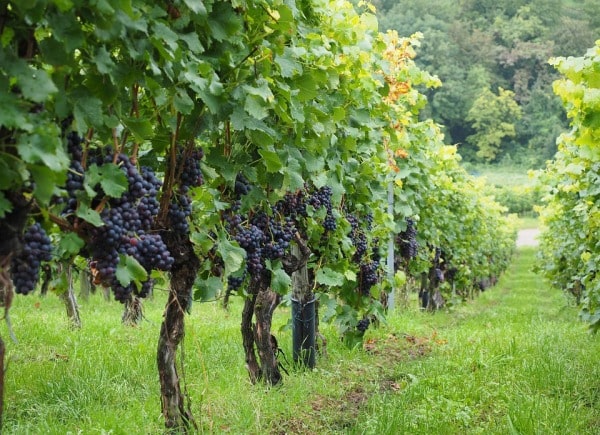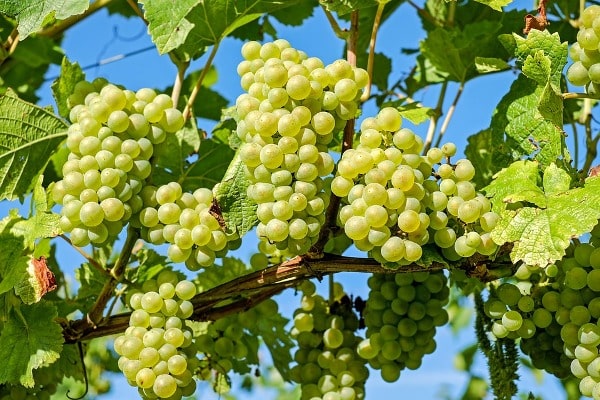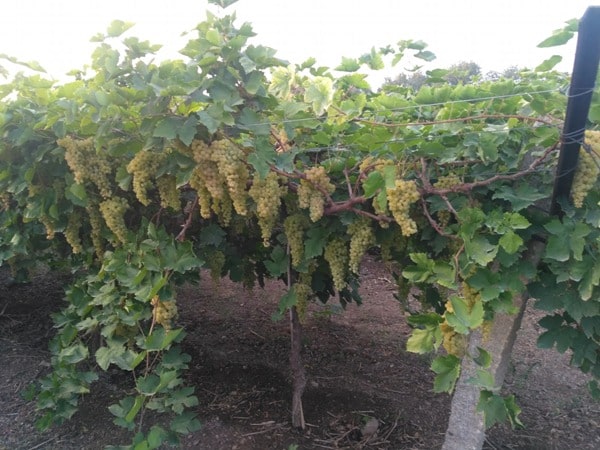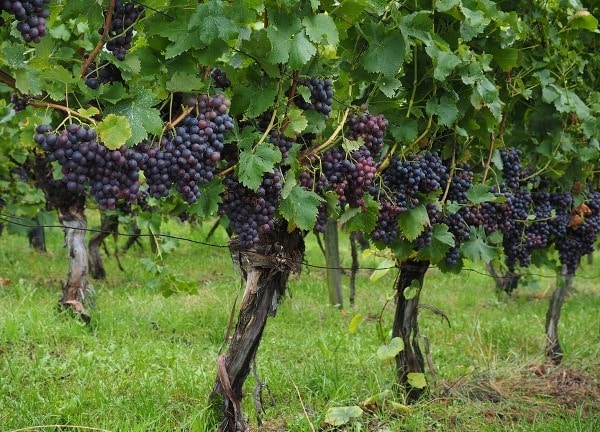Grape farming project report – introduction
The following information is about Grape Farming Project Report and Cultivation Practices.
Botanically grape is considered to be a berry of the flowering plant genus called Vitis. The grapevine is deciduous and woody in nature. This fruit appears in clusters and is non-climacteric. The cultivation of grapes was dated back to 8000 years ago in the East. Most of the grapes are native to the Mediterranean region and central Asia and very few varieties are native to America and Asia. Grapes are the fruits that grow in clusters and have many colors like crimson, black, dark blue, yellow, green, orange, pink, etc. The fruit is ellipsoidal in shape with 6 mm diameter and 3 cm in length approximately. The grape vines grow to a maximum height of 32 m and have stems with flaky bark. The leaves of the vine are alternately arranged and are palmately lobed. They are 5 -20 cm long and broad. The skin of the grapefruit has a naturally occurring micro-organism (yeast) over it, which facilitates the use of this fruit in the making of alcoholic drinks. Grapes all over the world are consumed in many forms such as fresh fruits, jam, juice, raisins, grape seed oil, grape seed extract, jelly, and wine. This grape farming project report describes the cultivation methodologies and at the end, one can find the details about the cost and profit associated with grape farming.
Grape farming project report – scope and importance
In India, it is estimated that grape farming is done over an area of 1.1 lakh hectares and the annual production is around 12 lakh tonnes. The production per unit area and the returns associated with grape farming are high, but the total area under cultivation has not increased over years because of the high initial cost of investment and equally high recurring cost of production. The weather of the country is unpredicted and poses a risk to the farmers. The major grape producing states in India are Andhra Pradesh, Karnataka, Maharashtra, and Tamil Nadu and these contribute around 90% of the total production. There is a need to expand the area under grape cultivation and diversify the uses of grapes. Efforts have to be made to organize post-harvest management methods like cold storage, etc. such that there is no loss. Focus on quality production and effective cost management can help the expansion and survival of the grape industry in India.

Grape farming project report – cultivars
There are more than 60 species of this genus and are subdivided into two major categories i.e. Euvitis and Muscadinia. Only three species belong to Muscadinia, whereas the remaining belong to Euvitis. In India, 1000 different varieties are grown in different places. Two major varieties of grapes are seeded and seedless.
The important seeded varieties are:
Anab-e-shahi
- Was introduced from the Middle East countries
- Mainly grown in Haryana, Punjab, Andhra Pradesh, and Karnataka
- Late maturing and high yielding variety
- The color of the fruit is amber and looks elongated
- The average yield of this variety is 35 tonnes/hectare
- Grown under a bower system of training
Bangalore blue
- Yields more than once in a year
- Grown under both bower and Kniffin systems
- Disease resistant cultivar, but prone to disorders
- The size of the berry is small, ovoid and purple in color
Cheema sahibi
- The fruit looks oval, medium in size and color is pale
Black champa
- Bunch is small with purple color spherical berries
- The yield may be medium.
Gulabi
- This variety is similar to Muscat Hamburg of Australia
- Found mostly in Tamil Nadu with names like Karachi, paneer drashai and Muscat
- The average yield of this variety is 10 to 12 tonnes per hectare
- Small bunches with spherical dark purple colored berries
Bhokri
- The color of the fruit is greenish yellow
- Grown in Tamil Nadu
- The average yield of the variety is 35 tonnes per hectare
The important seedless varieties are:
Beauty seedless
- Introduced from the USA
- Bunches are medium or large
- Berries are black and spherical
- Grown under Kniffin or head system of training
- Low keeping quality and berry drop are the two major drawbacks
- Moderately susceptible to diseases
Delight
- Found in the Northern states of the country
- Bunch size is medium, berries are round, green and small
- Good keeping quality, but less yield than perlette
Kishmish beli
- Introduced from Russia and most popular in Uzbekistan region
- Grown in Delhi, Abohar, and Hissar
- Large bunch formation with a poor color of berries
- Used for the table as well as raisin making
Perlette
- The fruit is translucent, soft, white and spherical
- Yield twice a year
Thompson Seedless
- Also known as Kishmish or sultana
- Most raisins are made from this variety
- Grown under a bower system of training
- Bunch is large, conical and compact
Apart from the above-mentioned varieties, there are some hybrid varieties cultivated in India. They are arkavati, arka neelmani, arka sweta, arka majestic, arka hans, arka kanchan etc.
Grape farming project report – fruit properties

The fruit is semi-translucent and fleshy with smooth thin skin. Some fruits contain seeds and others are seedless. The color of the fruit is due to the polyphenolic pigments present in them. The nutritional compounds present in grapes are listed here:
- The fruit is rich in polyphenolic phytochemicals like anthocyanins, resveratrol etc., which are anti-oxidant, anti-microbial and anti-inflammatory in nature.
- It contains a flavonoid tannin group of anti-oxidants like catechins.
- The berries have no cholesterol and very low calories. They have good potassium concentration.
- Grapes are a good source of vitamins like folate, niacin, riboflavin, pyridoxine, thiamin and vitamin A, C, E, and K.
- They also contain very small amounts of phytonutrients like carotene- alpha, carotene- beta, crypto-xanthin- beta and lutein-zeaxanthin.
- The fruit is also rich in micronutrients like calcium, iron, copper, zinc, magnesium, and manganese.
Grape farming project report – soil and climate requirements
The two important characteristics of the soil for grape farming are good internal drainage and adequate depth. Grapes can be typically grown in many varieties of soils. The minimum depth of the soil should be 75 cm to 1 m and there should be no obstructing layers within the soil. Exclusive soil type for grape farming could be sandy loam soil with average fertility. The soil should be permeable so that it drains well, helping the roots to grow and spread well. The pH range of the soil could be around 5.5 to 7.5. Soil containing clay should be avoided because it may have low drainage and salt accumulation.
Grape vines need constant weather conditions so as to allow the fruit to grow and the vegetative parts to mature. Sufficient sunlight provides enough carbohydrates such that the grape vines are healthy and the fruits are sweet. The grape plants are sensitive to freezing temperatures. The optimum temperature required for these plants is 15 to 40˚C and average rainfall should be around 50 to 60 cm. Very little rain is expected during the ripening season, which prevents various diseases from occurring. Overall weather for a grapevine should be like a warm day, cool night and low humidity. Winter is good for the plants, but frost is dangerous for the young buds.

Grape farming project report – propagation methods
Cultivators have several options for propagating the grape plant. The hardwood cuttings of a disease resistant variety are obtained from a vineyard and initially raised in a nursery. The different methods of propagation are through seeds, T-budding, bench grafting, layering, rooted cuttings, and tissue culture. Rootstocks with 4 nodes having 8 to 10 mm diameter are selected. These rootstocks are put in water for 24 hours such that the rooting inhibitors are leached out. The rootstocks are treated with IBA before planting to enhance growth.
Grape farming project report – land preparation and planting
The land for grape farming is ploughed thoroughly and levelled. Raised beds are created with proper drainage and irrigation channels. Generally, the vine is oriented to the north-south direction, such that leaves on both sides of the vines are exposed to sunlight. Training the vines into different patterns requires proper orientation of the vine rows.
Pits of dimensions 90 x 90 x 90 cm are marked and dug in a rectangular planting system. They are left open for 2 to 3 weeks. Topsoil, subsoil with organic manure or decomposed farm yard manure, 3 kg bone meal, 5 kg neem cake, 3 kg superphosphate and 500 g of muriate of potash are mixed well and filled in the pits. Chemicals are also added to the soil in the pits to prevent white ants. Rootstock which is four months old is planted into the pit. Planting is generally done during November- January (central India), December-January (south India) and February- March (north India). Light irrigation is given after planting.
Each variety of the plant has different planting density, but the most common spacing between vines is 4.5 x 4.5 m for anab-e-shahi, 7.2 x 3.6 m for Bangalore blue and 3 x 3 m for perlette and beauty seedless. The spacing between the rows depends greatly on what type of vine one wants to design.
Grape farming project report – irrigation requirements
Young vines need regular irrigation to grow well; minimum 20 liters of water per vine should be supplied each week in two or three irrigation cycles. Mature grape vines need a minimum of 100 to 300 liters of water each week. Irrigation can be given either by a surface method or drip method. In India, grape farms need 12 to 15 irrigation cycles in a season. Excessive irrigation should be avoided during flower initiation and berry development stages.
Grape farming project report – manure and fertilizer requirements
Moderately fertile soil is sufficient for cultivating grapes. Excessive fertile soil can help vegetative growth, which is problematic at times. Fertilizers should be applied 30 days before the growth begins in the grape vines, but before that at the time of planting 75 tonnes of organic manure, 5 tonnes of castor cake and 3 tonnes of superphosphate per hectare are applied. 3 to 4 weeks later a dose of 100 g urea, 200 g superphosphate and 250 g of castor cake are applied to each plant, this is done with a one-month interval for 6 months. The fertilizers to the grape vines are applied in a ring method. Shallow circular rings of 60 to 75 cm radius and 15 cm deep are created around each vine and fertilizers are applied in this ring. Fertilizers can also be applied through trenches created 45 to 60 cm away from either side of the rows. If a dripper is being used for irrigation then a pit of 10 to 15 cm below the dripper is evacuated to supply fertilizers.
Grape farming project report – pest and disease management
The pests that infest the grape vines are flea beetles, thrips, mealybugs, and leafhoppers. The common diseases found on the grape vines are powdery mildew, downy mildew, and anthracnose. These pests and diseases can be controlled by using some organic measures like the dasparni arka, cow dung, and urine, decoction of the acacia leaves etc.
Other than these diseases and pests causing harm to the grape vines, there are some physiological disorders that may occur in the vines such as water berries, cluster tip wilting, short berries, pink berries, bud and flower drop, poor maturing of the cane etc. The first important measure to control these problems is to avoid excessive irrigation to the farm. The mineral deficiency in the soil should be corrected and the berry bunches should be protected from direct sunlight in order to control the above disorders.
Grape farming project report – intercultural operations

Hoeing the land can help control the weeds that grow around the trunk of the vine. Weeds can also be controlled using proper chemical herbicides. Biologically weeds can be controlled by a method called mulching. Dry leaves or grass can be spread around the vines to control weed growth.
A very important method for grape cultivation is training the vines. To facilitate intercropping, fertilizing and harvesting training the young grape vines is necessary. This also helps to maintain proper structure and the spread of the vine. The main arm of the vine is the primary frame of the vine and it should be trained towards an east-west direction. The vine is allowed to grow only 60 cm high and then the shoots are tied with jute twines. All the auxiliary shoots are removed except the side shoots, which are allowed to grow at 40 to 45 cm interval. These side shoots are secondary shoots (canes) from which the fruiting spurs develop. The grape vines are trained in different systems such as:
- Head system
- Bower system
- Kniffin system
- Overhead trellis system or the T- trellis system
- Flat roof Gable system
Pruning is the removal of vegetative parts of a plant. 1 or 2 buds are left on the vine to develop, the remaining canes are pruned and this removal of dried canes is called back or growth pruning. The best months for pruning are September and October. Pinching the shoots is a part of pruning and it is mainly practiced to help the plant bear fruits. The tip of the main shoot is pinched when it attains 7 to 8 leaves. The terminal buds re-grow and start bearing fruits.
Grape farming project report – harvesting and yield
The color of the grape doesn’t always indicate its maturity, so grapes are taste-tested to check their level of maturity and then clusters of grapes are cut using a sharp knife. If the grapes don’t drop off the vine, then they should be left on it to ripen else they should be picked and stored in a cool, dry and ventilated place. Grapes that are grown for making raisins are generally harvested at a late stage. The blend ratio of sugar: acid should be 25: 30.1. The best harvesting time is during March or April. The cluster of grapes should not be pulled with a jerk otherwise this may crush the berries. The picked clusters should be gently placed in boxes and immediately moved into a shaded region.
The production of grapes is high in peninsular India and is estimated to be around 60 tonnes per hectare for the anab-e-shahi variety in south India. The average yield obtained from a grape vineyard is around 20 to 33 tonnes per hectare in the second or third year of planting. The yield increases in the subsequent years. The life of a grapevine is 15 years and the production and harvest are expected during the entire life span.
Grape farming project report – post-harvest management
Freshly picked grapes should be handled at low temperatures so as to limit the biochemical alteration processes. Generally, they are picked in the night and refrigerated immediately. Sometimes solid carbon dioxide is used to maintain a cool temperature for the grapes.
Sorting is done in the vineyard and all the distorted, damaged and diseased bunches are discarded.
Drying the grapes naturally on the ground or on shelves is a post-harvest management mechanism to increase the sugar concentration in the grapes. An alternative to this could be artificial drying using warm air.
Generally, the grapes for the local market are packed in the field immediately after harvest. Repeated handling may destroy the fruit, therefore it is directly packed into crates or boxes by properly shaping the bunch and discarding the defective berries. Sometimes, farmers harvest the grapes and it is brought to the shed for sorting and trimming. The packaging of grapes is done in a zip and slide polyethylene bags or perforated plastic clamshells. These packets are then placed in wooden crates, cardboard boxes, etc. and finally packed into cartons.
Grape farming project report – cost and profit analysis/economics of grape farming

The estimation for cultivating grapes in 1 hectare of land is being discussed here. The cost of material and labor may vary depending on the place of cultivation and their availability. The values presented here are to be taken as reference only. The practical deployment costs may vary from the theoretical values. The report doesn’t discuss land, transport, electricity, the design of the orchard (training system) etc. charges involved in the farming operations because these values are unpredictable and drastically vary according to the market value. One man-day refers to minimum hours of work a laborer can do in a day.
Material cost (Fixed costs)
The cost of each planting material: Rs 25 (may vary for different cultivars).
The no. of plants accommodated per hectare of land: 1980.
Labour charge per man-day: Rs 250.
Cost of manure per ton: Rs 750.
The average cost of fertilizers required per kg: Rs 12.
The average cost of bamboo sticks: Rs 10.
| Material and labor | Year 1 Investment (in Rs) |
| Cost of planting material @ Rs 25/plant | 49,500.00 |
| Cost of bamboo sticks @ Rs 10/stick | 19,800.00 |
| Cost of manure @ Rs 750/ton | 7500.00 |
| Cost of fertilizers @ Rs 12/kg | 9600.00 |
| Drip irrigation system | 55,000.00 |
| Borewell and pump set arrangement | 50,000.00 |
| Land preparation @ 7.41 pair days | 1852.50 |
| Pit marking @ Rs 100/manday for 9.88 man-days | 988.00 |
| Digging of pits @ 17.29 machine hours | 11238.50 |
| Filling the pits with manure and fertilizers @ 61.75 man-days | 15,437.50 |
| Planting the material @ 29.64 man-days | 7410.00 |
| Erecting the bamboo sticks @ 20 man-days | 5000.00 |
| Fencing the entire farm | 50,000.00 |
| Total initial investment | 2,83,326.50 |
Maintenance cost (Variable cost)
| Maintenance of farm | Investment in Rs year 1 |
| Manure application @ 49.4 man-days | 12,350.00 |
| Fertilizer application @ 50 man-days | 12,500.00 |
| Intercultural activities @ 44.46 man-days | 11,115.00 |
| Irrigating the farm @ 37.05 man-days and Rs 200/ man-day | 7410.00 |
| Manure @ 19.76 tonnes | 14,820.00 |
| Fertilizers @ 1811.33 kgs | 21,736.00 |
| Other micronutrients @ 113.2 kgs | 7000.00 |
| Total maintenance costs | 86,931.00 |
| Maintenance of farm | Investment in Rs year 2 |
| Manure application @ 56.81 man-days | 14,202.50 |
| Fertilizer application @ 61.75 man-days | 15,437.00 |
| Intercultural activities @ 116.09 man-days | 29,022.00 |
| Irrigating the farm @ 49.4 man-days and Rs 200/ man-day | 9880.00 |
| Harvesting @ 24.7 man-days | |
| Manure @ 29.64 tonnes | 22,230.00 |
| Fertilizers @ 2099.50 kgs | 25,194.00 |
| Other micronutrients @ 135.85 kgs | 8151.00 |
| Total maintenance costs | 1,24,116.00 |
The yield of grape vines in the 2nd year of planting is 6 tonnes per hectare (5,443.11 kgs).
The average cost of 1 kg grapes in India: Rs 60 (price may vary depending upon the cultivar).
Total income generated in the 2nd year: Rs 3, 26,586.60.
Profit generated in the 2nd year is: (Rs 3, 26,586- Rs 1, 24,116) = Rs 2, 02,470.60.
It is to be noted that every subsequent year the yield increases; 10 tonnes/hectare in the 3rd year, 13.58 tonnes per hectare in the 4th year etc.
Grape farming project report – loans and subsidies
Financial assistance is provided by the Department of Agriculture and Cooperation, Government of India under the National horticulture mission scheme and the pattern of assistance is in the form of 50% of the cost of expenditure related to planting and other materials given in 3 installments with a maximum permissible limit of Rs 1 lakh.
Please visit the NABARD website or the local office for horticulture development to get more information and an exact percentage of subsidy details for grape farming.
Read: Orange Farming Project Report.
Read: Growing Herbs and Spices.
I am interested in Grape Farming in Sindhudurga Dst.Kokan .I have land about one hectare with ample water resource and electricity supply.would like have joint venture partners .The information is really good and I am satisfied, would like your valued suggestions regarding atmospheric conditions like heavy rains and precautions
to be taken. thanks a lot.